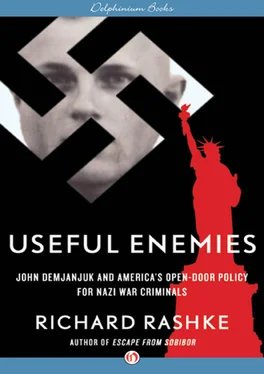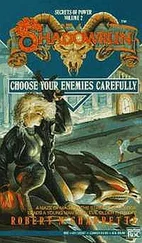Sheftel also brought a major bias to the defense team. He viewed the trial as a theatrical event and the courtroom as a Holocaust classroom designed to educate Israelis at Demjanjuk’s expense. He believed that Judge Levin’s first major courtroom decision proved his point.
Demjanjuk had admitted to all the facts about the Holocaust contained in the indictment save one—he was not Ivan the Terrible. Sheftel argued that, in accord with Israeli law concerning stipulations, the prosecution should be barred from presenting testimony about the history and nature of the Holocaust.
Judge Levin dismissed his opening-session objection and ruled: “We allow the prosecution to act as it sees fit and put forward evidence as it requires with respect to facts which are not in dispute.”
Translated: The fix was in. Demjanjuk’s goose was on the spit and the coals were red hot. No argument, no matter how cogent and convincing, could possibly stop his trip to the gallows because Israel would be “educated” only if Demjanjuk swung by a rope. The trial was bound to become a Roman arena “with everyone baying for the blood of Demjanjuk.”
The spectators got the message from the bench. At the close of the first session, after guards hustled Demjanjuk out of the courtroom amid screams of “murderer,” the audience turned on Sheftel like a pack of hyenas. “Kapo,” they yelled at him. “Nazi… Piece of filth… They should kill you … It’s a shame you are alive… Shameless bastard.”
The catcalling grew to a thunderous crescendo with angry, threatening gestures. Guards rushed to protect Sheftel, but he brushed them off. There was no way he would let a lynch mob intimidate him. He felt that his entire professional life had been a preparation for this trial. It was a watershed in his career, and no one was going to take away his opportunity and duty to defend John Demjanjuk.
Sheftel calmly walked down the aisle and out of the courtroom.
Sheftel even had the chutzpah to call the proceedings a “show trial” during an open court session, which earned him a contempt-of-court threat from Judge Levin. Sheftel apologized, but only after he had made his point. Totally humiliated by having to grovel before the court, he vowed to make the judges and prosecutors rue the day they got involved in the lynching of John Demjanjuk.
Like defense attorneys everywhere, Sheftel had a basic distrust of the police, especially their sneaky habit of showing photo spreads without a defense attorney present. That was precisely what Miriam Radiwker had done in the Demjanjuk case. Sheftel’s distrust was based on personal experience. He had never found a single instance where the Israeli police had conducted a proper photo spread in the absence of a defense attorney, and he was eager to flay police investigator Miriam Radiwker during his cross-examination of her photo identification procedures.
• • •
Sheftel began with the handwritten depositions she had taken from Treblinka survivors Avraham Goldfarb and Eugen Turowsky. Both men had testified at the Fedorenko trial in Fort Lauderdale. Both were now dead.
In an attempt to establish professional incompetence and bias, Sheftel challenged Radiwker about what she did not say in her written reports, but should have. Shades of defense attorney John Martin in Cleveland, who challenged document examiner Gideon Epstein on the tests he had not performed on the Trawniki card.
In accordance with memory-test guidelines, Sheftel would not allow Radiwker to consult her own original reports. Like O’Connor before him, his plan was to trap her in inconsistencies, then rattle her into self-doubt and frustration. Several times, he thought, he had confused her. But before he could go in for the kill, Judge Levin interrupted the flow of his cross-examination. It was almost as if Levin was trying to protect Radiwker, give her a rest, let her compose herself.
Under direct examination, Radiwker had testified from memory that she had shown Goldfarb three cardboard pages with a total of seventeen photos pasted on them. Sheftel held up a copy of the deposition that Radiwker had prepared and Goldfarb had signed. “It doesn’t say anywhere —‘pictures one to seventeen,’” Sheftel said.
Any attorney would see this as a trick question designed to confuse the witness. To a layman, however, it was a simple lie. Goldfarb had said in his sworn deposition: “I was shown seventeen photographs of Ukrainians on three brown cardboard sheets.”
Although Radiwker suspected Sheftel’s question was a trap, she insisted that she had shown Goldfarb all seventeen pictures and she did not ask Judge Levin for permission to review what she had written in the Goldfarb deposition eight years earlier. She’d catch Sheftel next time he tried to use the dirty trick.
The next time came when Sheftel questioned Radiwker about Goldfarb’s identification of Demjanjuk as Iwan Grozny. He was hoping to confuse her into admitting that she planted the name “Iwan” in his mind. That would be witness prompting and would invalidate the identification.
“Is it true,” Sheftel asked, “that when [Goldfarb] pointed to sixteen [Demjanjuk’s photo] and said ‘it looks familiar to me,’ he did not add the name Iwan?”
“Yes.”
“And a half hour later, you questioned him again?”
“Yes.”
“He refers to picture number sixteen… and he uses the name Iwan…. Did you mention the name Iwan?”
“I request permission to see the record.”
“What you are saying is: ‘I don’t remember?’”
“I am not saying I don’t remember. I am saying that because of the fact that I am not sure, I want to see the deposition.”
“You can’t remember without looking at your deposition?” Sheftel repeated, waving the papers in front of her.
“I don’t say I can’t,” Radiwker said. “I don’t believe your description of the content of my deposition.”
Sheftel did not appreciate the jab. “I would like to tell the bench,” he whined, “that it is not for her to give grades or marks to counsel.”
Judge Levin gave Radiwker permission to review her report. She read it, then answered Sheftel’s question: “I asked [Goldfarb] whether he remembered a Ukrainian by the name of Demjanjuk. He answered, ‘I do not remember the names of [the guards], but I do remember a Ukrainian by the name of Iwan.’”
Having lost that skirmish, Sheftel didn’t give up. He kept challenging Radiwker’s reports. Why didn’t you say this? Why did you say that? Didn’t you lead the witness here, suggest something there? Didn’t you send clues that Iwan Demjanjuk’s and Feodor Fedorenko’s photos were in the spread? Why did you interview witnesses twice? And when you did, why didn’t you write two separate reports?
Radiwker answered each question patiently, specifically, and clearly.
Sheftel called her attention to the photo spread. Radiwker admitted that the spread was far from perfect and that, at one point, she added three more pages of pictures to the three pages her supervisor had given her. She also admitted that she was inconsistent in presenting photos to the witnesses, sometimes showing the entire three pages, sometimes just page three, containing the photos of Demjanjuk and Fedorenko. On one occasion, she showed a witness only three photos. “I acted upon the guidelines [from INS],” Radiwker said in her defense.
“The guidelines said at least three,” Sheftel pointed out. “Why did you [sometimes] put thirty or forty in front of them?”
“I wanted to do it as well as I could…. I had more photos so I simply put more before the witnesses.”
“What’s the biggest picture on this page?” Sheftel asked, showing her page three of the photo spread.
Читать дальше












